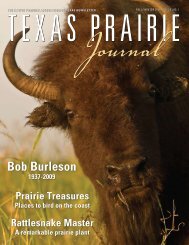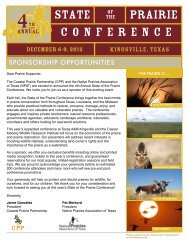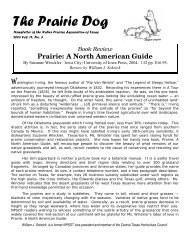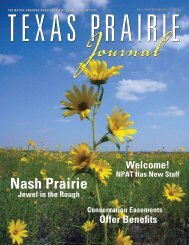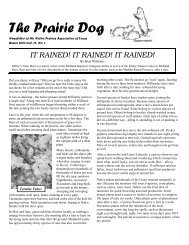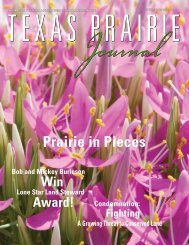2007 Fall/Winter issue - Native Prairies Association of Texas
2007 Fall/Winter issue - Native Prairies Association of Texas
2007 Fall/Winter issue - Native Prairies Association of Texas
You also want an ePaper? Increase the reach of your titles
YUMPU automatically turns print PDFs into web optimized ePapers that Google loves.
A Request for Grassland Soils<br />
Dear NPAT,<br />
I<br />
am<br />
writing today to see if anyone<br />
with the NPAT would be able to<br />
collect some soils from some <strong>Texas</strong><br />
prairies for a project I am heading up<br />
comparing grassland soils across North<br />
America. I’ve had a hard time finding<br />
contacts for <strong>Texas</strong> prairies, especially<br />
Blackland prairies.<br />
The broad goals <strong>of</strong> the project are to<br />
better understand the diversity and how<br />
grasslands work across North America:<br />
for example, going beyond just standard<br />
classifications <strong>of</strong> grasslands such as<br />
Palouse prairie or tallgrass. From an<br />
applied perspective, the research will help<br />
us understand continental-scale patterns<br />
<strong>of</strong> nutrient supply, susceptibility <strong>of</strong> the<br />
grasslands to changes in temperature or<br />
nitrogen deposition, and how to conserve<br />
plant diversity.<br />
This preliminary project on grassland soils<br />
is estimated to incorporate about 200 sites<br />
across the US and Canada, with sites from<br />
California to <strong>Texas</strong>, and Ohio to Florida<br />
already participating. Participation is pretty<br />
simple. Select two points that represent<br />
interesting contrasts in your grassland or<br />
prairie site. These might be the tops and<br />
bottoms <strong>of</strong> hills, grasslands dominated by<br />
perennials and annuals, or sandy soils and<br />
clayey soils. At each <strong>of</strong> the two points on<br />
your site, you’ll need to dig a hole 20 cm<br />
deep and place the soil in a 1-gallon Ziploc<br />
bag. Label the bags, fill out a short form that<br />
will ask for some basic information, and then<br />
take the two bags to the post <strong>of</strong>fice. At the<br />
post <strong>of</strong>fice, ask for a 11˝ x 8.5˝ x 5.5˝ flat rate<br />
box, which easily holds 2 gallons, and mail<br />
it to us here at Kansas State University. If<br />
you’d like us to pay for the postage, let me<br />
Photo Courtesy <strong>of</strong> Pat Merkord<br />
know and I’ll send along the $9 in postage<br />
(and Ziploc bags if you need those). Don’t<br />
worry about insulating the box—the soil<br />
will be just fine on its trip here to Manhattan,<br />
Kansas in October.<br />
When I get the soil, the samples will<br />
be used to answer questions that center<br />
on understanding the relationships<br />
between soil organic matter, microbial<br />
communities in the soil, and nutrient<br />
availability. In addition to some basic<br />
measures like soil pH, soil texture (how<br />
sandy the soil is), and some basic patterns<br />
<strong>of</strong> nutrient availability (potential nitrogen<br />
mineralization), the first project will be to<br />
grow plants in each soil in combination<br />
with different nutrients added as an index<br />
Information Request for <strong>Prairies</strong> and Savannas<br />
NPAT is looking for prairie and savanna remnants and restorations throughout<br />
<strong>Texas</strong>, especially in the Blackland Prairie, Coastal Prairie, and Grand Prairie (<strong>of</strong> the<br />
Cross Timbers and <strong>Prairies</strong>) regions <strong>of</strong> <strong>Texas</strong>.<br />
Knowledge <strong>of</strong> prairie remnants greatly assists us in conservation planning, and<br />
helps us identify land owners so we can inquire about their interest in protecting<br />
their prairie.<br />
If you know <strong>of</strong> any existing remnants (even drive-by sightings or just rumors), own<br />
a prairie remnant, or are restoring prairie on your land, please contact NPAT via email<br />
at info@texasprairie.org or write to 2002 - A Guadalupe St. PMB 290, Austin, Tx<br />
78705-5609.<br />
<strong>of</strong> nutrient limitation. This should<br />
give us an index <strong>of</strong> which nutrients<br />
limit plant growth at a site. Assays<br />
<strong>of</strong> soil organic matter quality are<br />
also planned in order to understand<br />
how carbon is stored in the soils<br />
and its role in supplying nutrients<br />
to plants. Soils not used for these<br />
projects will be archived so that<br />
other researchers can ask different<br />
questions in the future.<br />
Beyond this immediate project,<br />
the long-term goal is to set up a<br />
national network <strong>of</strong> grassland<br />
monitoring and research—one<br />
that might coordinate research<br />
on other aspects <strong>of</strong> grasslands<br />
like plants and insects. Not only<br />
would contributing soil help to<br />
see how your grassland or prairie<br />
compares to others in North<br />
America, but showing that we<br />
can coordinate sample collection<br />
across a broad number <strong>of</strong> sites<br />
managed by a diverse group <strong>of</strong><br />
organizations will be a good step toward<br />
this larger goal.<br />
If you are willing to take part, in an<br />
email, let me know the following:<br />
1) How many sites are you planning<br />
Most people will contribute two points at<br />
one site, but others had <strong>of</strong>fered to collect<br />
soils from more than one site. If you plan<br />
to hit more than one site, we should talk.<br />
2) Should we send you postage Our<br />
budget is somewhat limited on this, so if<br />
you can pay for postage, that’ll help us<br />
support other sites that can’t.<br />
3) Will you be able to send soils to us<br />
before Nov. 1 If not, let me know and<br />
we’ll schedule soils being sent.<br />
If you can help out, I will email more<br />
specific instructions and a short form to<br />
fill out for each site. It’ll ask for specifics<br />
on the location like GPS coordinates (if<br />
possible). Also, if there are permission<br />
forms I need to fill out, let me know and<br />
I’ll get on that.<br />
If you want more information, let me<br />
know and I’ll give you a call.<br />
Thanks,<br />
Joseph Craine<br />
Division <strong>of</strong> Biology<br />
Kansas State University<br />
Manhattan KS 66506-4901<br />
Email: jcraine@ksu.edu<br />
<strong>Fall</strong>/<strong>Winter</strong> <strong>2007</strong><br />
native <strong>Prairies</strong> <strong>Association</strong> <strong>of</strong> <strong>Texas</strong><br />
3



